1999 HONDA CIVIC COUPE window
[x] Cancel search: windowPage 149 of 269
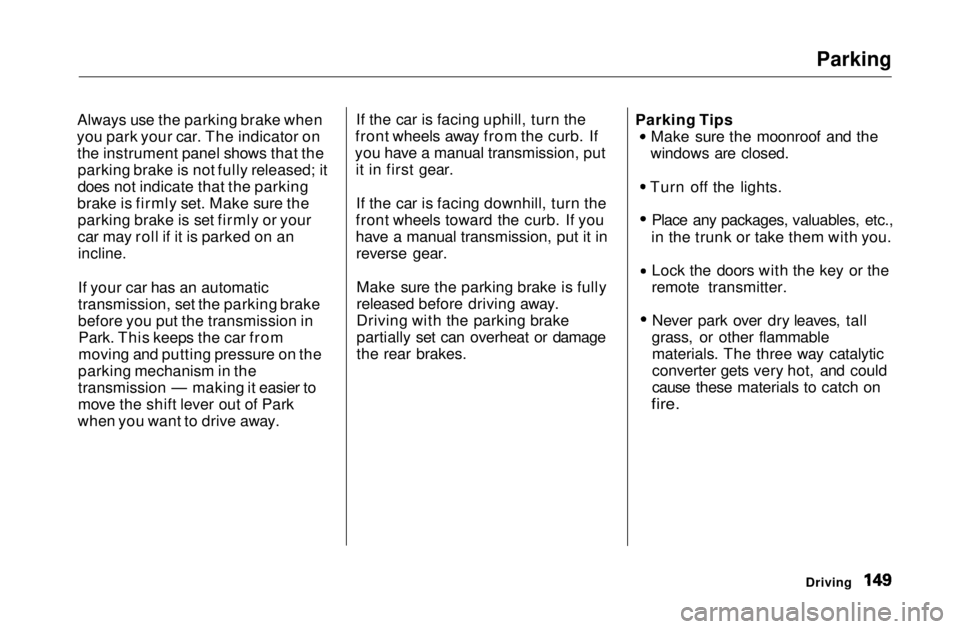
Parking
Always use the parking brake when
you park your car. The indicator on the instrument panel shows that theparking brake is not fully released; it
does not indicate that the parking
brake is firmly set. Make sure the parking brake is set firmly or your
car may roll if it is parked on an
incline.
If your car has an automatic
transmission, set the parking brake
before you put the transmission inPark. This keeps the car from
moving and putting pressure on the
parking mechanism in the
transmission — making it easier to
move the shift lever out of Park
when you want to drive away. If the car is facing uphill, turn the
front wheels away from the curb. If
you have a manual transmission, put it in first gear.
If the car is facing downhill, turn the
front wheels toward the curb. If you
have a manual transmission, put it in reverse gear.
Make sure the parking brake is fully
released before driving away.
Driving with the parking brake
partially set can overheat or damage
the rear brakes. Parking Tips Make sure the moonroof and the
windows are closed. Turn off the lights.
Place any packages, valuables, etc.,
in the trunk or take them with you. Lock the doors with the key or the
remote transmitter.
Never park over dry leaves, tall
grass, or other flammable materials. The three way catalytic
converter gets very hot, and could
cause these materials to catch on
fire.
DrivingMain Menu Table of Contents s t
Page 154 of 269
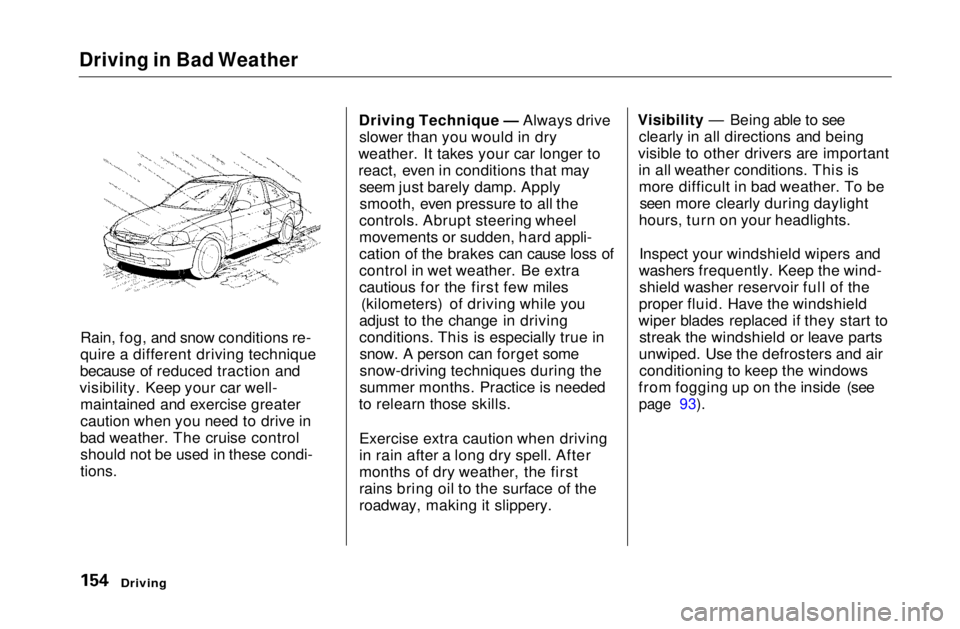
Driving in Bad Weather
Rain, fog, and snow conditions re-
quire a different driving technique
because of reduced traction and
visibility. Keep your car well- maintained and exercise greater
caution when you need to drive in
bad weather. The cruise control should not be used in these condi-
tions.
Driving Technique — Always drive
slower than you would in dry
weather. It takes your car longer to
react, even in conditions that may seem just barely damp. Applysmooth, even pressure to all the
controls. Abrupt steering wheel
movements or sudden, hard appli-
cation of the brakes can cause loss of
control in wet weather. Be extra
cautious for the first few miles (kilometers) of driving while you
adjust to the change in driving
conditions. This is especially true in snow. A person can forget some
snow-driving techniques during the
summer months. Practice is needed
to relearn those skills.
Exercise extra caution when driving
in rain after a long dry spell. After
months of dry weather, the first
rains bring oil to the surface of the
roadway, making it slippery. Visibility — Being able to see
clearly in all directions and being
visible to other drivers are important in all weather conditions. This ismore difficult in bad weather. To be seen more clearly during daylight
hours, turn on your headlights.
Inspect your windshield wipers and
washers frequently. Keep the wind- shield washer reservoir full of the
proper fluid. Have the windshield
wiper blades replaced if they start to streak the windshield or leave parts
unwiped. Use the defrosters and air conditioning to keep the windows
from fogging up on the inside (see
page 93).
DrivingMain Menu Table of Contents s t
Page 188 of 269
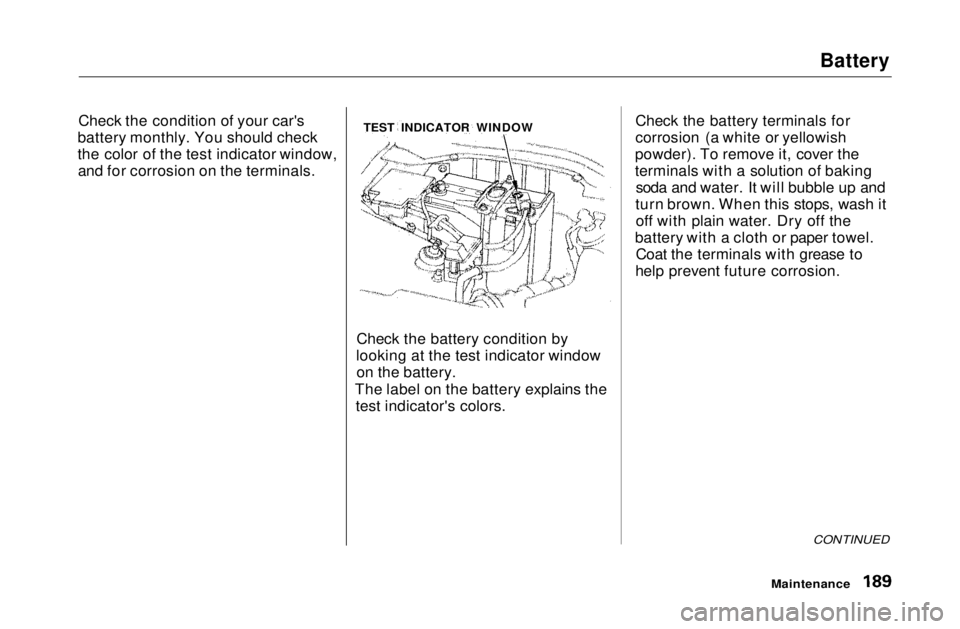
Battery
Check the condition of your car's
battery monthly. You should check
the color of the test indicator window, and for corrosion on the terminals.
Check the battery condition by
looking at the test indicator window on the battery.
The label on the battery explains the test indicator's colors. Check the battery terminals for
corrosion (a white or yellowish
powder). To remove it, cover the
terminals with a solution of baking soda and water. It will bubble up and
turn brown. When this stops, wash it off with plain water. Dry off the
battery with a cloth or paper towel. Coat the terminals with grease to
help prevent future corrosion.
CONTINUED
Maintenance
TEST INDICATOR WINDOWMain Menu Table of Contents s t
Page 211 of 269
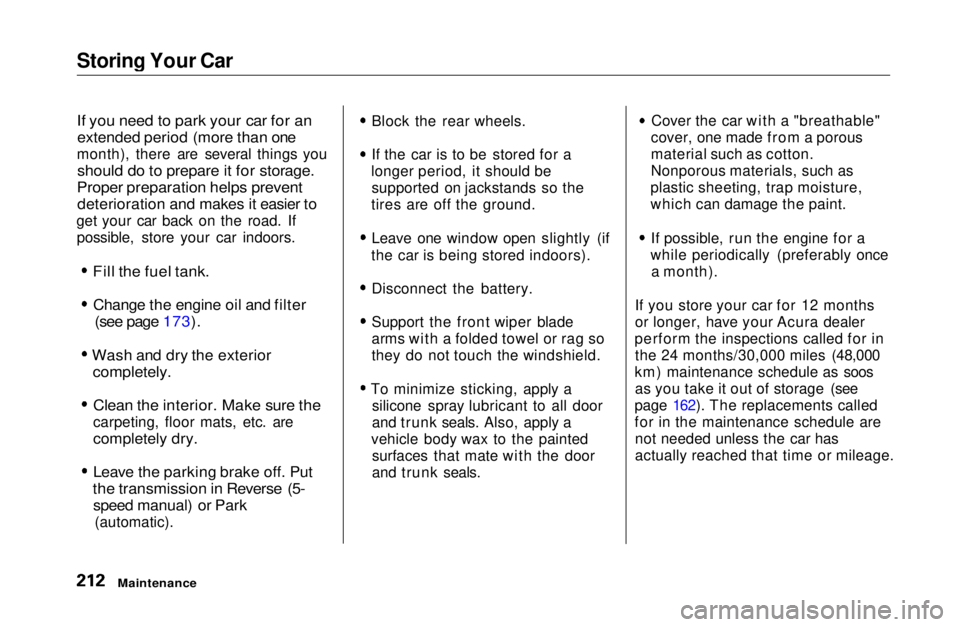
Storing Your Car
If you need to park your car for an
extended period (more than one
month), there are several things you
should do to prepare it for storage.
Proper preparation helps prevent
deterioration and makes it easier to
get your car back on the road. If possible, store your car indoors.
Fill the fuel tank.
Change the engine oil and filter
(see page 173).
Wash and dry the exterior
completely.
Clean the interior. Make sure the
carpeting, floor mats, etc. are
completely dry.
Leave the parking brake off. Put
the transmission in Reverse (5-
speed manual) or Park
(automatic). Block the rear wheels.
If the car is to be stored for a
longer period, it should be supported on jackstands so the
tires are off the ground.
Leave one window open slightly (if
the car is being stored indoors).
Disconnect the battery.
Support the front wiper blade
arms with a folded towel or rag so
they do not touch the windshield.
To minimize sticking, apply a silicone spray lubricant to all door
and trunk seals. Also, apply a
vehicle body wax to the painted surfaces that mate with the door
and trunk seals. Cover the car with a "breathable"
cover, one made from a porous
material such as cotton.
Nonporous materials, such as
plastic sheeting, trap moisture,
which can damage the paint.
If possible, run the engine for a
while periodically (preferably once a month).
If you store your car for 12 months
or longer, have your Acura dealer
perform the inspections called for in the 24 months/30,000 miles (48,000
km) maintenance schedule as soos as you take it out of storage (see
page 162). The replacements called
for in the maintenance schedule are not needed unless the car has
actually reached that time or mileage.
MaintenanceMain Menu Table of Contents s t
Page 212 of 269

Appearance Care
Regular cleaning and polishing of
your Honda helps to keep it "new" looking. This section gives you hintson how to clean your car and
preserve its appearance: the paint,
brightwork, wheels and interior. Also included are several things you can
do to help prevent corrosion.
Exterior Care.................................. 214 Washing...................................... 214
Waxing........................................ 214
Aluminum Wheels..................... 215Paint Touch-up........................... 215
Interior Care................................... 216 Carpeting.................................... 216
Fabric.......................................... 216
Vinyl............................................ 216
Seat Belts.................................... 216
Windows..................................... 217
Air Fresheners........................... 217
Corrosion Protection..................... 217
Body Repairs..................................218
Appearance CareMain Menu s t
Page 216 of 269
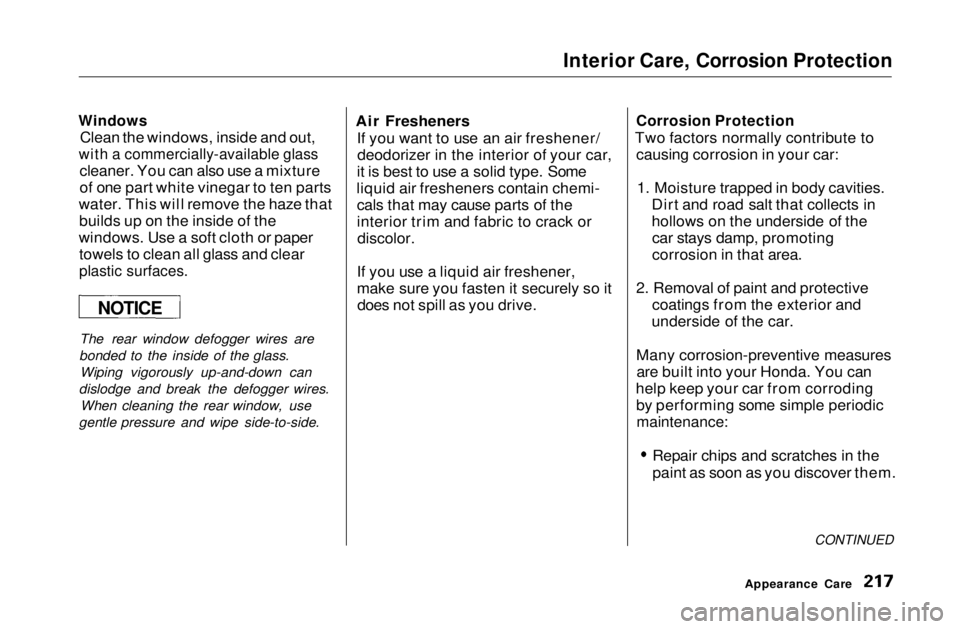
Interior Care, Corrosion Protection
Windows
Clean the windows, inside and out,
with a commercially-available glass
cleaner. You can also use a mixture
of one part white vinegar to ten parts
water. This will remove the haze that builds up on the inside of the
windows. Use a soft cloth or paper towels to clean all glass and clear
plastic surfaces.
The rear window defogger wires are
bonded to the inside of the glass. Wiping vigorously up-and-down can
dislodge and break the defogger wires. When cleaning the rear window, use
gentle pressure and wipe side-to-side. Air Fresheners
If you want to use an air freshener/deodorizer in the interior of your car,
it is best to use a solid type. Some
liquid air fresheners contain chemi- cals that may cause parts of the
interior trim and fabric to crack ordiscolor.
If you use a liquid air freshener,
make sure you fasten it securely so it does not spill as you drive.
Corrosion Protection
Two factors normally contribute to causing corrosion in your car:
1. Moisture trapped in body cavities. Dirt and road salt that collects in
hollows on the underside of thecar stays damp, promoting
corrosion in that area.
2. Removal of paint and protective coatings from the exterior and
underside of the car.
Many corrosion-preventive measures are built into your Honda. You can
help keep your car from corroding by performing some simple periodic
maintenance:
Repair chips and scratches in the
paint as soon as you discover them.
CONTINUED
Appearance Care
NOTICEMain Menu Table of Contents s t
Page 231 of 269
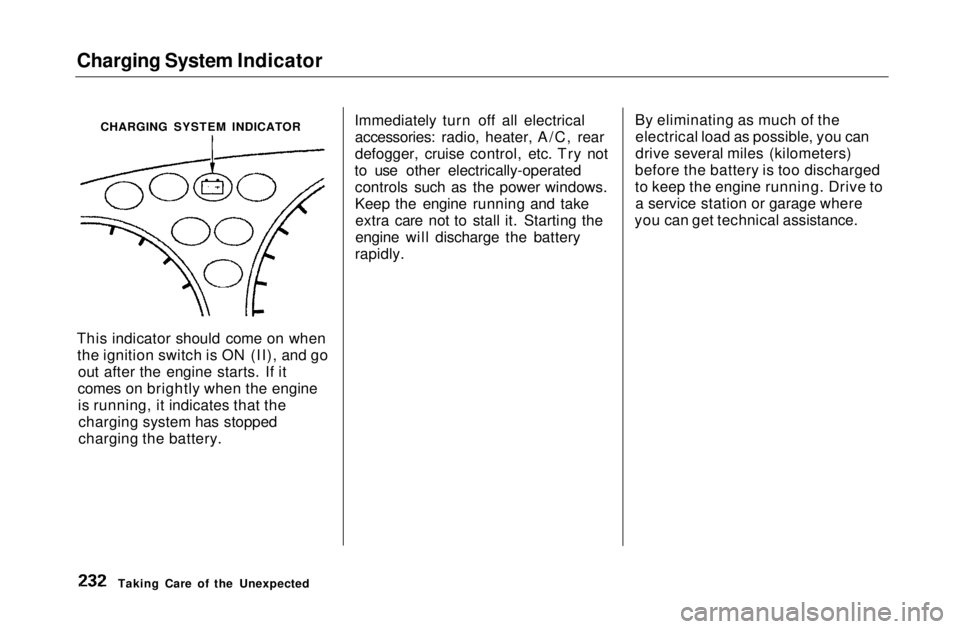
Charging System Indicator
This indicator should come on when
the ignition switch is ON (II), and go out after the engine starts. If it
comes on brightly when the engine is running, it indicates that thecharging system has stopped
charging the battery. Immediately turn off all electrical
accessories: radio, heater, A/C, rear
defogger, cruise control, etc. Try not
to use other electrically-operated controls such as the power windows.
Keep the engine running and takeextra care not to stall it. Starting the
engine will discharge the battery
rapidly. By eliminating as much of the
electrical load as possible, you can
drive several miles (kilometers)
before the battery is too discharged
to keep the engine running. Drive to a service station or garage where
you can get technical assistance.
Taking Care of the Unexpected
CHARGING SYSTEM INDICATORMain Menu Table of Contents s t
Page 261 of 269

Index
Before Driving............................... 123
Belts, Seat........................................... 8
Beverage Holder.............................. 84
Body Repair.................................... 214
Brakes Anti-lock System (ABS)............ 151Break-in, New Linings .............. 124
Fluid............................................ 182
Light, Burned-out...................... 206
Parking.......................................... 82
System Indicator.......................... 55
Wear Indicators......................... 150
Brakes, ABS Operation.................................... 150
System Indicator................. 55, 153
Braking System.............................. 150
Break-in, New Car......................... 124
Brightness Control, Instruments... 62
Brights, Headlights......................... 61
Bulb Replacement Back-up Lights........................... 207
Brake Lights ...................... 206, 207
Front Parking Lights................. 205
Front Side Marker Lights......... 205
Headlights.................................. 204
High-mount Brake Light.......... 209
Interior Light.............................. 210
License Plate Lights.................. 209
Rear Side Marker Lights.......... 206
Specifications............................. 248
Trunk Light................................ 211
Turn Signal Lights............. 205, 206
Bulbs, Halogen............................... 204
Cables, Jump Starting With.......... 227
Capacities Chart............................. 247
Carbon Monoxide Hazard.............. 49
Carrying Cargo.............................. 132
Cassette Player
Operation.................................... 115
CAUTION, Explanation of............... ii
CD Changer.................................... 100
CD Player........................................ 100
Certification Label......................... 244
Chains............................................. 201
Change Oil
How to......................................... 173
When to....................................... 162
Changing a Flat Tire..................... 221
Changing Engine Coolant............. 177 Charging System Indicator.... 55, 232
Checking
Automatic Transmission
Fluid........................................ 180
Battery Condition...................... 189
Brake Fluid................................. 183
Clutch Fluid................................ 183
Drive Belts.................................. 194
Engine Coolant........................... 128
Engine Oil................................... 127
Fuses........................................... 236
Manual Transmission Fluid ..... 182
Power Steering Fluid................. 184
Checklist, Before Driving............. 136
Cleaner, Air.................................... 185
Cleaning Exterior....................................... 214
Interior........................................ 216 Seat Belts.................................... 216
Vinyl............................................ 216 Windows..................................... 217
Clock, Setting the ............................ 99
Clutch Fluid.................................... 183
CO in the Exhaust......................... 254
Cold Weather, Starting in............. 137
Compact Spare............................... 220Main Menu s t